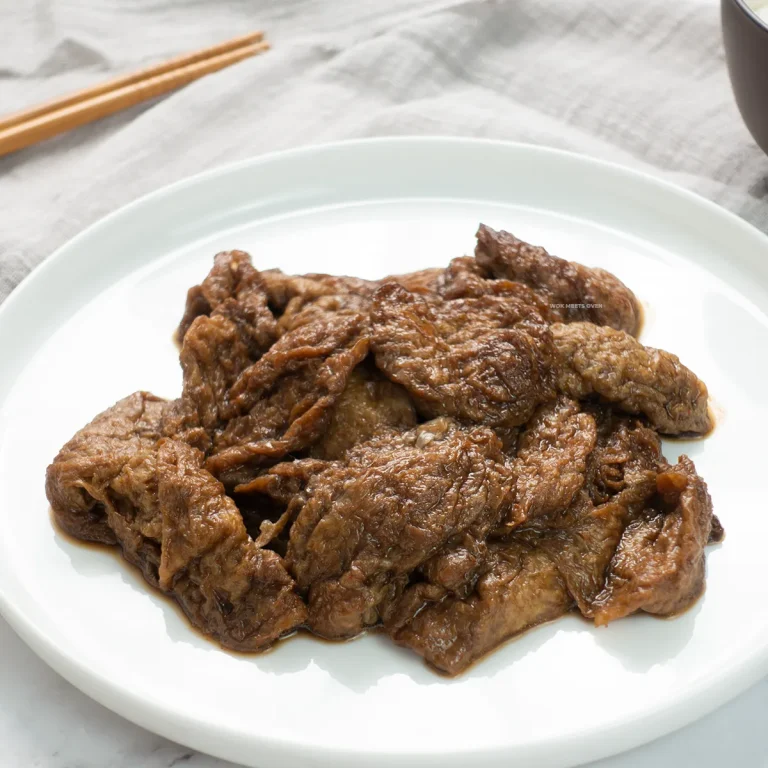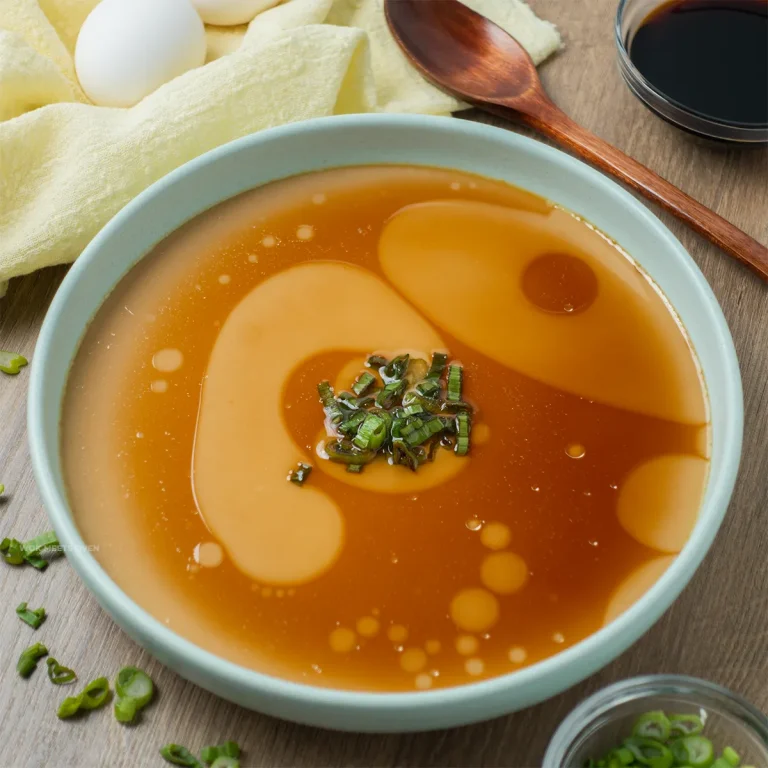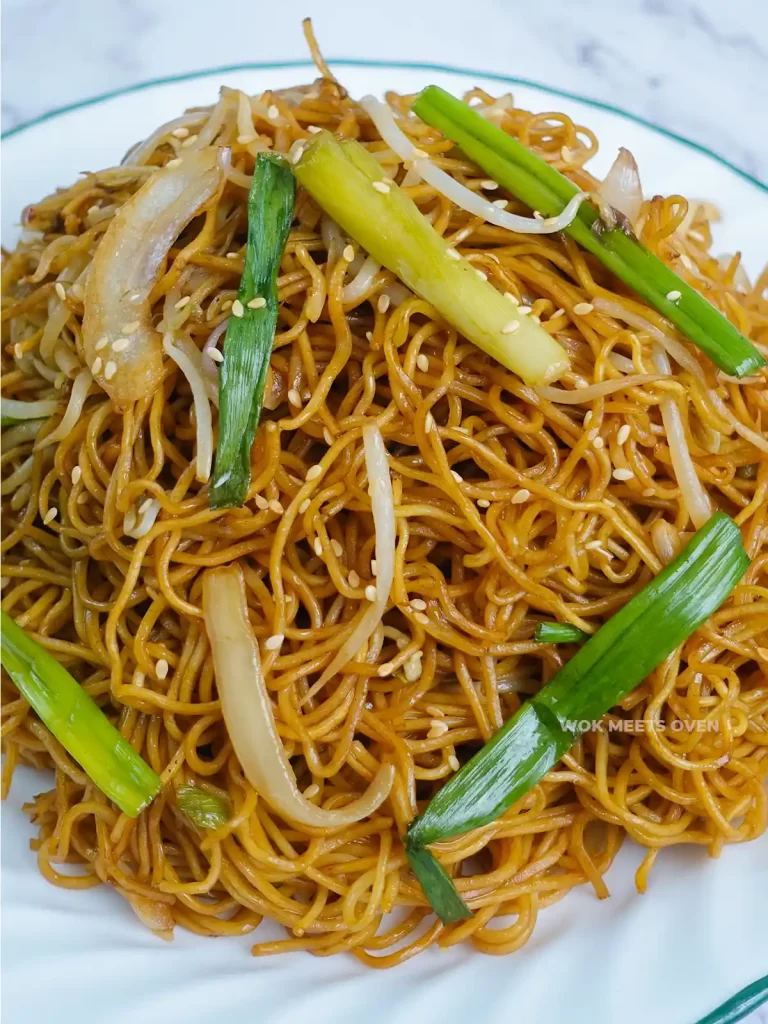Hong Kong Style Shredded Pork Pan-fried Noodles
Crispy egg noodles pan-fried to perfection and smothered in a rich and delectable sauce loaded with shredded pork, mushrooms, and fresh beansprouts. This easy Hong Kong style shredded pork pan-fried noodles recipe will leave you wanting seconds!

Introduction
Recently I made a youtube video and blog post about Cantonese soy sauce chow mein noodles, one of my favorite Cantonese dishes to order when having early morning tea (yum cha) aka dim sum. I had bought several extra bags of fresh chow mein noodles as an insurance policy incase I needed to refilm certain scenes or if I needed to re-take photos for my thumbnails. Usually when filming or taking photos for my thumbnails 9 times out of 10, something goes wrong 🤦♂️
Luckily though, the filming and photoshoot went as planned (mostly) this time, but as a result of this, I was left with some extra chow mein noodles that I needed to use. I was brought up to never waste food growing up in a working class family that was always worried about finances, so I needed to figure out what to do with the leftover noodles.
Now since I’m a noodle kind of guy, this was easy especially when it comes to chow mein noodles as I must have eaten chow mein noodles thousands of times and its easily ranked right up there as one of my favorite Chinese dishes.
I foraged through my kitchen looking for whatever ingredients I had available to me, and saw that I still had some leftover beansprouts from making my soy sauce chow mein noodles and also some pork in freezer. This gave me the idea to create this Cantonese fried noodles with shredded pork recipe for you guys.
What is Shredded Pork Pan-fried Noodles?
Hong Kong pan fried noodles with shredded pork or 肉絲炒麵 in Cantonese is a very popular Cantonese pork chow mein dish that you will typically find at a Cantonese Chinese restaurant.
The dish consists of fresh chow mein egg noodles that have been pan-fried, creating a crunchy and crispy outer exterior while the interior remains soft and chewy. This gives the noodles an interesting contrasting texture when biting into it.
The noodles are then smothered in a rich thick savory gravy sauce that has either julienned pork or pork slices along with beansprouts and other vegetables like Chinese chives, mushrooms, and onions.
There will be variations in what type of vegetables are used in the recipe and each person can cater it based on their own personal preference but the pork is necessary hence the name “pan fried noodles with pork”.
And please do not mix up pan-fried noodles with lo-mein noodles. Both the technique and type of noodle used are completely DIFFERENT!!! I’ve seen so many people title their recipes “pan-fried noodles” only to use lo mein and stir-fry their noodles 🤦♂️. Even in American style “Chinese food” Lo mein dishes are stir-fried and not pan-fried so I don’t know where they got the pan-fried part from.
Lo in Cantonese literally means to stir/toss or mix and mein means noodles. So Lo mein literally means tossed/mixed noodles, not pan-fried.
Now on the other hand, when we say pan-fried noodles, we literally mean that the noodles will be pan-fried like in this recipe here and not mixed or tossed around in the wok. The noodles are pan-fried until they are crispy on the outside while still soft on the inside on both sides. This is how you know the chef has done a great job with the noodles. If on the other hand, the noodles taste like they are fried and the inside is hard and crunchy then the chef screwed up!
The Type of Noodles You Use Matters!
Now in addition to how you prepare the noodles, the type of noodles that you use also greatly matters!
Far too many people, think they are making “pan-fried noodles” or “chow mein” just because they picked up a bag of noodles at the grocery store with Chinese characters on it 🤦♂️
The usual culprit is using Lo mein and calling the recipe “pan-fried”.
In some extreme cases, I have even seen people use instant noodles as their “chow mein” noodles.
True story, back when I was in middle school, one guy in my class literally bought several bags of mr.noodles instant noodles to our family studies class one day when we were supposed to be cooking chow mein noodles🙄.
Lo mein noodles are a type of egg noodles that are much thicker and chewier then chow mein noodles and are usually reserved for stir-fry recipes or even some soup based recipes. These noodles are never pan-fried. Furthermore, they seem to be only available in America as I have yet to find a single Asian grocery store here in Canada selling them. The closet thing I have found resembling them are yau noodles, which are typically used in Shanghai style stir-fry dishes.

Chow mein noodles on the other hand are thin egg noodles that can be either stir-fried or pan-fried. When you go to an authentic Chinese restaurant, especially outside of America and you order Chow mein, they will usually serve you this type of noodles.
And when your buying chow mein noodles at an Asian grocery store, it literally says “chow mein” on the cover. But if your buying “chow mein noodles” at a regular grocery store be very careful here as I have seen some manufacturers selling “chow mein” noodles which didn’t resemble authentic chow mein noodles the least bit, or it’s some sort of local version of chow mein noodles that’s country specific and not used anywhere else in the world.
For this recipe in particular, we are using fresh chow mein noodles as they tend to have a better texture and more springiness to it when you bite into it.
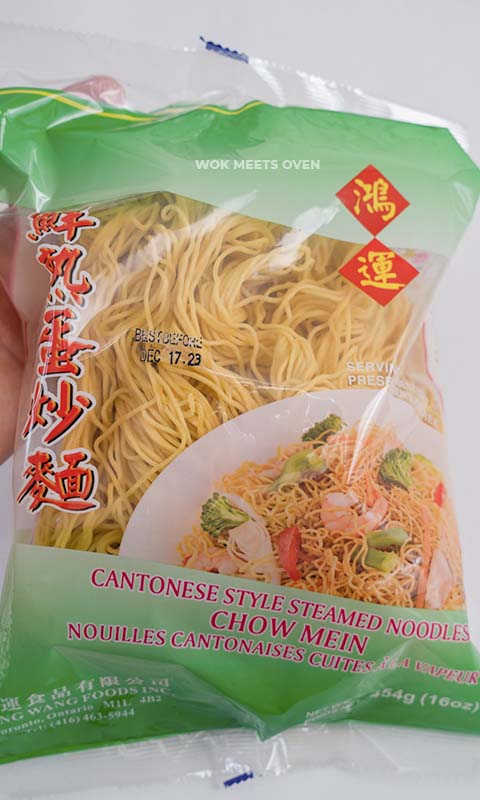
How to Make Cantonese Shredded Pork Fried Noodles
When it comes to cooking meals, I believe in 3 things:
- It should be affordable
- It should not be overly complicated
- It shouldn’t take too long
And luckily, Cantonese pork fried noodles checks off all 3.
Most if not all of these ingredients will be readily available in Most Asian households but if your not Asian, you can easily find these ingredients at a local Asian supermarket or even a regular one.
The ingredients don’t cost an arm or leg either and is very budget friendly, great for times when greedflation is running rampant in many countries.
Here’s what you’ll need to make shredded pork pan fried noodles:
Ingredients
- Bag of fresh chow mein noodles 454g
- Mung Bean sprouts 150-200g
- Green onion stalks 3-4
- Half of a medium sized yellow onion
- Shiitake mushrooms 5-6 pieces
- 3-4 garlic cloves (minced)
- Pork shoulder 150g
Sauce:
- Oyster sauce 2 Tbsp
- Soy sauce 2 Tbsp
- White granulated sugar 1 tsp
- White pepper 1 tsp
- Chicken powder 1 tsp
- Chicken stock about 2-2.5 cups
Pork marinade:
- 1 tsp of soy sauce
- 1 tsp of white granulated sugar
- 1 tsp of chinese cooking wine
- 1 tsp of ground white pepper
- 1 tsp of corn starch
- 1 tsp of neutral cooking oil
Cornstarch slurry:
- 4-5 Tbsp of corn starch (can adjust based on how thick you want your sauce)
- 4-5 Tbsp of water


Ingredient notes
Fresh chow mein noodles: For this recipe, we’ll be using fresh chow mein noodles that have already been partially cooked. You will need to blanch the noodles in hot water for about a minute prior to use. These noodles should be regularly stocked at most Asian grocery stores.
Pork: For this dish, I’m using pork shoulder as I find it has a good ratio of leaness to fat. But other cuts of pork that work well are pork butt, and even pork loin if you really want a nice slap of lean cut meat.
Vegetables: I’m using mung bean sprouts with some dried shiitake mushrooms. Make sure when buying bean sprouts that they are fresh and white looking. If the bean sprouts look transparent and start to feel slimy then they are going to expire soon. For the shiitake mushrooms, you will need to rehydrate them if your using dried shiitake mushrooms.
Substitutions
Fresh chow mein noodles: In the unfortunate event that your neighborhood does not carry fresh chow mein noodles, then the next best candidate would be dried egg noodles, but make sure to use the non-flavoured kind as some brands add in extra flavouring such as shrimp to the noodles. You don’t want the flavoring to overpower the taste of the noodles.
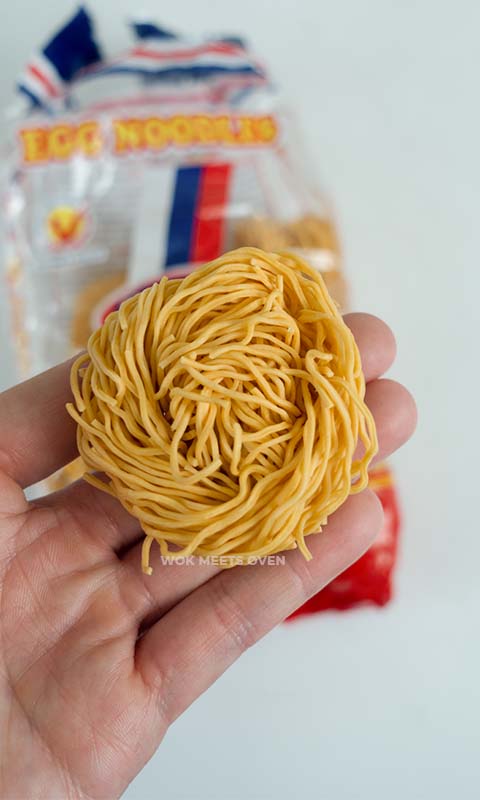
So it’s either fresh chow mein noodles or dried egg noodles. I am sorry but there is no other compromise or further discussion on this matter. That means no lo mein or instant noodles 😠 I’m watching you like a hawk!!!

If your vegetarian then I have great news for you. They make and sell a vegetarian version of chow mein noodles that look and taste nearly identical to the original version. YAY!!! 🎉🍾


Protein: Butt pork, pork loin, pork neck, even pork belly if you love extra fatty cuts of meat. I’m not a big fan of fatty cuts of meat because I have magic powers that allows me to put on weight instantaneously but some people don’t have this superpower so pork belly is fine in this case. You can also use chicken, or beef as well, however I will be saving those versions for a later recipe in the future (wink wink) 😉.
If you’re vegetarian, then you can either just use the veggies and leave out the protein or you can add in Chinese beancurd vegetarian meat as a substitute. Again available at your local Asian grocery store 😁
Vegetables: This recipe is kind of flexible with the veggies, and there’s nothing stopping you from using something else, however I would caution straying too far off from the typical veggies used like beansprouts or mushrooms. You can use fresh mushrooms instead of dried and you can add in extra vegetables like carrot or use red onions instead of yellow. In addition, you can also add in Chinese chives. A lot of places like to use Chinese chives in there shredded pork fried noodles recipe.
Directions
Soaking the dried shiitake mushrooms
Prior to making the dish, it is recommended to soak the dried shiitake mushrooms in water either the night before or at least 2-3 hours prior to making the dish to rehydrate the mushrooms and make them soft again. Let the mushrooms soak in the water for at least one hour and then discard the water. Refill the bowl with fresh water and let the mushrooms soak up the water again for at least another hour. Once done, remove the mushrooms from the water and squeeze out all of the liquid and set it aside for slicing.

Slice each piece of mushroom into strips. The size will depend on your personal preference but I like to slice mines about an inch wide. I also recommend cutting off the stems from the mushroom as well.
Preparing the noodles
Once the mushrooms have been prepared, it’s time to prepare our noodles.
Boil a large pot of water. Once the water is boiling, turn off the stove and then dump your pack of fresh chow mein noodles into the pot to blanch it. Loosen up the noodles so that they don’t stick together using chopsticks or tongs.
Let the noodles blanch for about a minute in the hot water before removing it from the pot and straining out all of the water.

Do not rinse the water under cold water while straining it!
Now add in a little bit of oil and then loosen up the noodles to prevent them from sticking together using chopsticks or some tongs.
Then, transfer the noodles to a tray, and line the noodles evenly on the tray to allow it to cool down and not clump together.
We’re going to air dry the noodles. This helps maintain the chewy and bouncy texture of the noodles as opposed to running it under cold water.

Marinating the pork
Next we’re going to prepare the pork shoulder.
Julienne the pork shoulder and place it on a bowl. Make sure when slicing the pork that you are slicing it against the grain eg. in the opposite direction as the lines you see on the meat. If you were to cut it parallel to the grain then your pork will taste tough when eating it.

Tip: I recommend that you semi-freeze the pork shoulder prior to slicing it to make cutting it a lot easier.
Next add in soy sauce, white granulated sugar, white ground pepper, Chinese cooking wine, and the corn starch into the bowl. Mix everything well together so that the pork is evenly coated with the marinade. Then add in your cooking oil and mix it in with the pork as well. Once done, set it aside or place it in the fridge if you aren’t planning on making the dish immediately.
Preparing the rest of the vegetables
Grab your green onion stalks and cut them into 2-3 inch long pieces and set it aside.
Next grab half of a medium sized yellow onion and cut it into strips and set it aside.
Now mince 3-4 cloves of garlic and also set it aside.

Wash the beansprouts in cold water and then drain out all of the water and let it rest in a colander to dry.
Preparing the sauce
In a small bowl, add in your oyster sauce, soy sauce, white granulated sugar, white pepper, and chicken powder. Mix everything well together and set it aside.
Cooking the noodles
Once our noodles have fully cooled down, it’s time to pan-fry it.
In a heated wok, add in about 2 Tbsp of cooking oil. Let the oil heat up and then add in your noodles. I recommend adding them in batches so as to not overcrowd the wok and allow the noodles to become crispy.
After you have added the noodles, shape it into a round circle using chopsticks and then don’t touch the noodles. Allow the noodles to cook and crisp up over medium heat in the wok. After about 3-4 minutes check the bottom of the noodles and see if it has become crispy. Once the bottom of the noodles has become crispy, flip the noodles over and cook the noodles for another 3-4 minutes. Add a little bit of cooking oil to the edge of the wok as well as your cooking the noodles in case there is not enough oil.

Once both sides of the noodles have become crispy, remove it from the wok and set it aside. Repeat the process for the second batch of the noodles.
Tip: I recommend that you place the noodles on some paper towels or a metal strainer to drain out all of the excess oil from the noodles.
Cooking the Rest of the Ingredients
Heat your wok back up to medium heat, add in about a Tbsp of oil then add in your marinated pork. Cook both sides of the pork strips to about 80% done then remove it from the wok. The pork should look mostly white with barely any pink visible. Don’t worry we’ll be adding it back in to our sauce later when we’re making it.
Next add in about a tsp of oil to the wok, heat it up to medium heat and then dump your onions in. Cook the onions for about 1-1.5 minutes then add in the minced garlic followed by the white part of the green onions, stir-fry that for about 20 seconds, followed by adding in your mushrooms. Continue stir-frying this for about 1 minute.
Now add in your sauce mixture. Mix the sauce well and then add in your chicken stock to the wok and mix everything well together. Turn up the heat to about medium-high and once you start to see the sauce simmer, add in your cornstarch slurry, making sure to stir the wok with your spatula while you slowly pour in the cornstarch. Once the sauce has become thickened, add back in your pork slices from earlier followed by the beansprouts. Mix everything well together for about 30 seconds. Turn off the heat, add in the green parts of the green onion you cut earlier. Mix everything together for another 30 seconds and transfer the sauce out of the wok.

Pour the sauce right on top of the crispy pan-fried noodles when you are ready to serve the dish.


Tips
Allow the blanched noodles to fully cool down before cooking them. This step not only allows the noodles to retain it’s nice bouncy and chewy texture but it also helps prevent the noodles from sticking to your wok as well. You can air dry the noodles by lining them up on a baking tray and just let nature do it’s thing.
When adding in the noodles to the wok, do not touch the noodles to allow it time to crisp up a bit.
When cooking the beansprouts, make sure that you are using medium-high to high heat to prevent excess water from coming out of the beansprouts. Also do not overcook the vegetables otherwise they will become overly soft and lose its crunchiness.
I recommend cooking the noodles in batches rather than overcrowding the wok so that the noodles get evenly cooked.
Since we are pan-frying the noodles, I recommend that you strain out all of the oil once you are done pan-frying it to make it “healthier” and reduce the amount of calories in the dish.
It is recommended to semi-freeze the pork prior to cutting it as this will make slicing the pork a lot easier.
How to Store Leftovers and Re-Heating the Noodles
You can store any leftovers in the fridge in an airtight container. The noodles and sauce keep well for about 3-4 days. Once you are ready to eat the noodles, just heat everything up and serve.
Frequently Asked Questions (F.A.Q.S)
I’m Allergic to Egg, What Can I Substitute It With?
You can substitute regular chow mein noodles with vegetarian style chow mein noodles that don’t contain egg. They just add in food colouring to the noodles to give it that nice yellow colour but there’s no egg in it, at least that’s what they list in the ingredients. But If you end up needing to go see a doctor due to an allergic reaction from consuming eggs, it’s not my fault.
Can I Use Instant Noodles Instead of Chow Mein Noodles?
No!
Can I Use Lo Mein Noodles as a Replacement for Fresh Chow Mein Noodles?
No! Lo mein noodles are much thicker and tend to go well with saucy dishes that allow it to soak up all of the juices. Chow mein noodles on the other hand are much thinner, and because we will be lightly pan-frying the noodles to make it slightly crispy too, you want to use thinner noodles.
Can I Use Spaghetti in Place of Chow Mein Noodles?
Sure, why not? And while we’re at it, let’s just call this dish shredded pork pan-fried spaghetti noodles. How about that?
The answer is NO!
What Other Types of Noodles Can I Use Instead of Chow Mein Noodles?
You can substitute vegetarian chow mein noodles if regular chow mein noodles are not available. You can also substitute fresh chow mein noodles with dried thin egg noodles as well.
Can I Use Sesame Oil to Cook the Dish?
If you want your dish to taste of nothing but sesame then sure, go ahead but if you want to actually taste the food then save the sesame oil as a garnish for the end.
Why Are My Noodles Sticking Together When Cooking?
Did you rinse the blanched noodles under cold water after blanching them? Avoid rinsing the noodles under cold water right after blanching them and allow them to air dry.
Also add in about a tsp of oil to the blanched noodles after straining out all of the water and mix it to further prevent the noodles from sticking together.
Why Are My Noodles Overly Soft and Soggy?
Did you boil the noodles instead of blanching them? Did you cook the noodles for too long? We’re not making pasta here folks! Only blanch the noodles without the stove on for no more than 1 minute then immediately remove it from the stove and strain it.
Do I Need to Use a Wok to Make This Dish?
Nope, but I would highly recommend getting one if you intend on making a lot of Asian dishes. Plus a wok gives you way more room to mix and flip things. But in the meantime, a regular frying pan is fine.
Other Cooking Recipes You’ll Love

Hong Kong Style Shredded Pork Pan-fried Noodles
Equipment
- 1 Wok
Ingredients
- 454 g Bag of fresh chow mein noodles
- 150-200 g Mung beansprouts
- 3-4 stalks Green onion
- half medium Yellow onion
- 5-6 pieces Shiitake mushrooms
- 3-4 cloves Garlic Minced
- 150-200 g Pork shoulder
Sauce
- 2 Tbsp Oyster sauce
- 2 Tbsp Light soy sauce
- 1 tsp White granulated sugar
- 1 tsp White pepper
- 1 tsp Chicken powder
- 1.5-2 Cups Chicken stock
Pork marinade
- 1 tsp Soy sauce
- 1 tsp White granulated sugar
- 1 tsp Chinese cooking wine shaoxing wine
- 1 tsp Ground white pepper
- 1 tsp Corn starch
- 1 tsp Cooking oil
Corn starch slurry
- 4-5 Tbsp Corn starch
- 4-5 Tbsp Water
Instructions
Soaking the dried shiitake mushrooms
- Prior to making the dish, it is recommended to soak the dried shiitake mushrooms in water either the night before or at least 2-3 hours prior to making the dish to rehydrate the mushrooms and make them soft again. Let the mushrooms soak in the water for at least one hour and then discard the water.
- Refill the bowl with fresh water and let the mushrooms soak up the water again for at least another hour. Once done, remove the mushrooms from the water and squeeze out all of the liquid and set it aside for slicing.
- Slice each piece of mushroom into strips. The size will depend on your personal preference but I like to slice mines about an inch wide.
Preparing the noodles
- Boil a large pot of water. Once the water is boiling, turn off the stove and then dump your pack of fresh chow mein noodles into the pot to blanch it. Loosen up the noodles so that they don’t stick together using chopsticks or tongs.
- Let the noodles blanch for about a minute in the hot water before removing it from the pot and straining out all of the water.
- Do not rinse the water under cold water while straining it!
- Now add in a little bit of oil and then loosen up the noodles to prevent them from sticking together using chopsticks or some tongs.
- Then, transfer the noodles to a tray, and line the noodles evenly on the tray to allow it to cool down and not clump together.
- We’re going to air dry the noodles. This helps maintain the chewy and bouncy texture of the noodles as opposed to running it under cold water.
Marinating the pork
- Julienne the pork shoulder and place it on a bowl. Make sure when slicing the pork that you are slicing it against the grain eg. in the opposite direction as the lines you see on the meat. If you were to cut it parallel to the grain then your pork will taste tough when eating it.
- Next add in soy sauce, white granulated sugar, white ground pepper, Chinese cooking wine, and the corn starch into the bowl. Mix everything well together so that the pork is evenly coated with the marinade. Then add in your cooking oil and mix it in with the pork as well. Once done, set it aside or place it in the fridge if you aren't planning on making the dish immediately.
Preparing the rest of the vegetables
- Grab your green onion stalks and cut them into 2-3 inch long pieces and set it aside.
- Next grab half of a medium sized yellow onion and cut it into strips and set it aside.
- Now mince 3-4 cloves of garlic and also set it aside.
- Wash the beansprouts in cold water and then drain out all of the water and let it rest in a colander to dry.
Preparing the sauce
- In a small bowl, add in your oyster sauce, soy sauce, white granulated sugar, white pepper, and chicken powder. Mix everything well together and set it aside.
Cooking the noodles
- Once our noodles have fully cooled down, it's time to pan-fry it.
- In a heated wok, add in about 2 Tbsp of cooking oil. Let the oil heat up and then add in your noodles. I recommend adding them in batches so as to not overcrowd the wok and allow the noodles to become crispy.
- After you have added the noodles, shape it into a round circle using chopsticks and then don't touch the noodles. Allow the noodles to cook and crisp up over medium heat in the wok. After about 3-4 minutes check the bottom of the noodles and see if it has become crispy.
- Once the bottom of the noodles has become crispy, flip the noodles over and cook the noodles for another 3-4 minutes. Add a little bit of cooking oil to the edge of the wok as well as your cooking the noodles in case there is not enough oil.
- Once both sides of the noodles have become crispy, remove it from the wok and set it aside. Repeat the process for the second batch of the noodles.
Cooking the rest of the ingredients
- Heat your wok back up to medium heat, add in about a Tbsp of oil then add in your marinated pork. Cook both sides of the pork strips to about 80% done then remove it from the wok. The pork should look mostly white with barely any pink visible. Don't worry we'll be adding it back in to our sauce later when we're making it.
- Next add in about a tsp of oil to the wok, heat it up to medium heat and then dump your onions in. Cook the onions for about 1-1.5 minutes then add in the minced garlic followed by the white part of the green onions, stir-fry that for about 20 seconds, followed by adding in your mushrooms. Continue stir-frying this for about 1 minute.
- Now add in your sauce mixture. Mix the sauce well and then add in your chicken stock to the wok and mix everything well together. Turn up the heat to about medium-high and once you start to see the sauce simmer, add in your cornstarch slurry, making sure to stir the wok with your spatula while you slowly pour in the cornstarch.
- Once the sauce has become thickened, add back in your pork slices from earlier followed by the beansprouts. Mix everything well together for about 30 seconds. Turn off the heat, add in the green parts of the green onion you cut earlier. Mix everything together for another 30 seconds and transfer the sauce out of the wok.
- Pour the sauce right on top of the crispy pan-fried noodles when you are ready to serve the dish.


